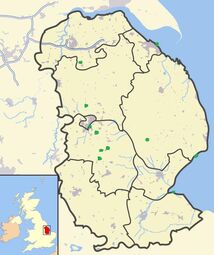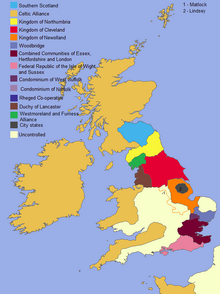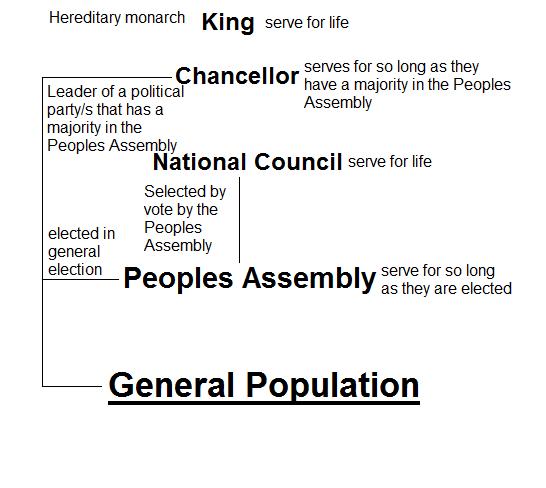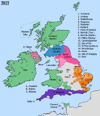God and my right | ||||||||||||
| Capital | Bourne | |||||||||||
| Largest city | Spalding | |||||||||||
| Other cities | Ely, Kings Lynn | |||||||||||
| Language official |
English (British) | |||||||||||
| others | English (Lincolnshire dialect), English (American) | |||||||||||
| Religion main |
Church of England | |||||||||||
| others | Roman Catholic, Baptist, Islam | |||||||||||
| Ethnic Groups main |
British | |||||||||||
| others | Anglo-American, Afro-American | |||||||||||
| Government | Democratic Constitutional Monarchy | |||||||||||
| Area | 833 km² | |||||||||||
| Population | est. 123,000 | |||||||||||
| Currency | Pound | |||||||||||
East Britain was a British survivor nation in the former English county of Lincolnshire. Founded in 1984, East Britain became the nation of Newolland in 2011.
History
Formation
East Britain was formed in 1984 when Bourne hadn’t had contact with the rest of Lincolnshire for six months since Doomsday. The Bourne District Council seized control of Bourne’s main industries, set up the ‘State Guardsmen’ and set up special camps for refugees coming in from the nearby hamlets. Since half of Lincolnshire was nuclear wasteland and not knowing what the condition in the rest of the country was like, the Bourne District Council changed its name to the East Britain National Council and declared Bourne and the surrounding areas the Provisional State of East Britain.
There had been some debate over whether to call the new state Brunnia after the town of Bourne itself or to call it East England. The Council however, decided that the wisest decision would not be Brunnia because it would not represent other peoples they annexed. East England would also be unwise because the Council decided that the concept of England not Britain had been growing towards Doomsday and they decided that the concept of Englishness had not taken Britain to any good places. So East Britain it was. Over a matter of weeks East Britain used the A15 to advance past Morton and occupied the land around Bourne by about four miles. By November 1986, East Britain occupied an area of roughly a third of South Kesteven.

Green-areas targeted by nuclear weaponry. The areas of future East Britain survived.
Spaldingas-East British War
East Britain suffered a brief war when completing the occupation of Spalding and the surrounding areas. An English nationalist group had governed the area prior to East British agents influencing, manipulating and destabilising politics in the area to the pint where East Britain was necessary to provide law and order. After occupation however, the remnants of the government saw what had happened and rose against East Britain. The State Guardsmen were utilised in a set piece battle for the first time. There were worries that the military was too ill-equipped and unadvanced to take on the more technologically advanced Spaldingas. The Spaldingas had access to a number of rifles and pistols which they had acquired through the criminal underground.
Hope
Fortunately, the State Guardsmen were under the command of one Steve Cartwright. Cartwright had been a bus driver prior to Doomsday, but after his conscription into the Guardsmen, it became clear he had a gift. He could 'read' a battlefield in a fashion similar to Wellington or Napier. During his training it became apparent that he could master tactics that took most men years to perfect, in a matter of months. When the war began, the National Council appointed him High General.
The Battle of Welland
The first battle of the war, the Guardsmen faced an army a third larger than their own and armed with pistols and rifles. The Guardsmen were armed mostly with crossbows and shotguns, along with their customary short swords. The first attack came with a rattle of gunfire as the enemy launched an attack with their rifles. Casualties fell, but General Cartwright had taken the precaution of equipping his soldiers with thick wooden shields. They were primitive but effective and are estimated to have saved hundreds of lives. In the camp behind the Guardsmen, civilians were toiling away, using drainpipes and filtered marshgas from the Fens to construct gas propelled artillery. Cartwright had to hold his ground as he waited for his artillery to be finished. A charge by the Spaldingas in an attempt to drive back the Guardsmen was utterly decimated by a well timed volley by Cartwright. The Spaldingas were shocked at the speed at which the Guardsmen reloaded their crossbows, a notoriously complicated weapon which is difficult to reload. This was thanks to the scrupulous drill that Cartwright took care to instill in his troops. In a few short minutes, the Spaldingas charge was crushed. But any attempt by the East British to charge themselves would be even more brutally put down. It had taken four volleys to down the charge. It would only take one to decimate the East British. But they need not worry for the artillery was now ready. With improvised explosive devices loaded into their artillery they opened fire. The buildings in which the Spaldingas sharpshooters and the remainder of that army resided was blown apart as incendiaries of swampgas, grenades of improvised gunpowder and rocks bludgeoned the masonry. Two hours later the remnants of the enemy army crawled from the rubble and offered their surrender. They were placed in an internment camp and the Union Flag was raised over the rubble.
The Battle of Tulip Flower
This is the last and most famous of the Spaldingas-East British War. The battle took place in and around an old tulip field, hence the name. The artillery of both sides had been bludgeoning each other for weeks. There was no hope of using the terrain as cover since it was completely flat and there were no trees. This time, however, the Guardsmen were equipped with captured weaponry from the Spaldingas. Of course this weaponry was only temporary as they did not have the infrastructure to provide ammunition for these guns. Large quantities of ammunition were only available for shotguns. The artillery stopped on 3rd May 2001 and the East British soldiers rose from their trenches and charged. The Spaldingas troops fired and many soldiers fell. What they couldn't know was that this forces was equipped with specially thickened uniforms to dull the effect of bullets. What they also couldn't know as that under the mist of the early morning, General Cartwright was committing a flanking action. Just as the Spaldingas troops lowered their weapons, believing the bodies in front of them to be dead, a charge came into their right flank. The soldiers were caught completely off guardas they suffered not only a blow from their right flank but the 'dead' soldiers in front of them got up again and helped their friends. The enemy was routed and the Spaldingas officially offered their unconditional surrender. Cartwright was a hero and became famous throughout East Britain. His actions during the war earned him a place in history, the equal of other military heroes throughout history.
Crises
In 2005 an energy crisis occurred when the gas plant in Bourne shut down. The gas supply it was connected to had reached a point of degradation where it was simply inoperable. The Council shut down the plant and temporarily used fermented sugar beet to produce alcohol for fuel. The Council then constructed some wind turbines near Pinchbeck to produce East Britain's energy needs. To do this East Britain occupied a few miles of South Holland. In 2006 the pumps at the Fens shut down and the Fens flooded resulting in a swift construction of windmills to aid the pumping away of water from Bourne and East British core territories. Bourne became a coastal town for the first time since the Middle Ages.
The active separatist guerilla group known as the Sons of De Montfort were an active rival of the government until 2018, when they finally succeeded in establishing Leicestershire as an independent state.
Contact
It was through this link to the sea that they made contact with other nations in England like Woodbridge and the Kingdom of Cleveland. And through them the Celtic Alliance they finally made contact with the rest of the world including New Britain. Upon learning that the United Kingdom had been officially disbanded in the 80’s, East Britain began considering removing their provisional status and developing their own status as a nation state.
Restoration
On the 3rd May 2010, the East Britain National Council voted unanimously for a restoration of the monarchy under a new elected monarch. This new monarch is the eminent and esteemed member of the Council, William Harrison. Though an old man, he has worked tirelessly for the upkeep of his country and its people and the decision was made that as he was so dedicated, it would only be fitting for him and his descendants to be the Royal family of East Britain. In a way similar to the Cocos Island monarchs, King William has refused to accept the construction of a palace or royal vestments. This is because he would prefer the resources to be put into the upkeep and expansion of East Britain.
Invasion of the Isle of Eels
As part of a greater offensive, East Britain contributed towards the destruction of the TBA presence in East Anglia. While Woodbridgers stormed across Norfolk and Essaxons launched an assault on Southeastern Cambridge, East Britons invaded Northern Cambridge and other parts of Lincolnshire. Woodbridge completed its branch of the assault easily, whereas Essex suffered greatly. East Britain found itself in a not so happy medium. Though the conquest was easy, the consolidation was much more difficult.
After the wars had ended, it was felt necessary to show the saftety of the new territories and thus between July 3rd and July 10th Lee Evans, Prime Minister John Robson, and King William of East Britain along with a large retinue and only token guards walked on foot from Spalding to Southend via Ely, Newmarket, Bury St Edmunds, Stowmarket, Sudbury, Chelmsford, and Billericay. It was intended to demonstrate that people could walk with confidence from one nation to the next, and it worked, drawing large crowds and media attention. Prime Minister Robson also took the opportunity to visit the graves of the Woodbridge soldiers found by East British troops after the Battle of Ely.
True Nationhood
Much of the East British efforts in recent years in restoring order, bringing about democracy, the success of its armed forces, and a new monarchy to rally behind has stirred a new nationalist feeling in East Britons, and the Newolland Act established Newolland as the official successor to East Britain. The name is derived from the name for southern Lincolnshire, and is slightly altered due to corruption in the language since Doomsday. This was hailed as sweeping away the remnants of the old order, and the creation of a new state, unique and independent in the British Isles.
Politics
Government
William is the King and head of state.
There are three tiers of government. The lower tier is the Peoples Assembly. The Assembly is made up politicians elected from constituencies. There are 100 Members of Assembly (MA) and they are elected in a general election held every five years. The Assembly suggests laws and acts which are put to a vote then passed to the higher tier. The leader of the Assembly is the Chancellor who is elected by the people and their party holds a majority in Parliament.
The Chancellor leads a major political party, generally commands a majority in the Assembly, and is the leader of the Council. As such, the incumbent wields both legislative and executive powers.
The higher tier is the National Council. The Council is made up of a clique of politicians selected by the Assembly. There are 20 Councillors. Most have some kind of military decoration and most come from Bourne. They serve for life. They can block laws from the Assembly and amend laws from the Assembly before passing them onto the third tier. Their leader is the Chancellor
The final tier is the monarch who can block any and all laws at any stage of development they can also amend laws though this requires a majority vote from both the Council and the Assembly. The monarch can also create laws and these go down to the Assembly for approval.
Parties
There are five major parties in the National Council. They are the Agricultural Party, the Expansionist Party, the Industrialist Party, the Municipal Party and the British Party. The Agricultural Party favours expansion into the countryside and the maintainance of large collective farms. The Expansionists favour expanding into the countryside, building settlements and encouraging small-scale sustainable farming. The Industrialist favour concentrating on industry and only expanding if it is really necessary. The Municipal Party favours concentrating on building cities and encouraging population growth before any expansion is even considered. The British Party is in favour of the preservation of the British national identity and co-operation between the British survivor states.

There is one other party in the Peoples Assembly, the Immigration Party. The Immigration Party encourages immigration to East Britain to increase the population and make them an economic powerhouse. The Imperial Party was wiped out at the last election.
Line of Succession
The rule of primogeniture does not count in the East British monarchy. Instead the heir to the throne would be the eldest child regardless of gender. So the first twelve in the line of succession would be:
- Crown Princess Linda (Daughter of King William)
- Prince Robert (Son of Princess Linda)
- Prince Edward (Son of Princess Linda)
- Princess Julie (Daughter of King William)
- Prince Stuart (Son of Princess Julie)
- Prince Daniel (Son of Princess Julie) or Princess Rachel (Daughter of Princess Julie)
- Prince Mark (Son of King William)
- Princess Keziah (Daughter of Prince Mark)
- Princess Marianne (Daughter of Prince Mark)
- Princess Leah (Daughter of Prince Mark)
In the case of Prince Daniel and Princess Rachel who are twins, the National Council would select who they think would be most suitable for the job.
Law and Order
Life is a very precious thing in the sparsely populated Fens. For this reason, and because of the former UK's humanitarian past, there is no death penalty. There are too few people as it is so the preservation of what populace they have is paramount and a big political issue. There is an independent judiciary and there is trial by jury. The highest level of Judiciary is the National Court. The Court is composed of the finest legal minds in East Britain.
International Relations
East Britain has very good relations with Woodbridge from whom it relies to provide them with more up to date fire arms than aged shotguns and their crude melee weapons. Although the people of East Britain have learned of the dissolution of the United Kingdom, they see no reason to stop their current status as British state. They show little interest in the Celtic Alliance or New Britain, seeing the closer countries of Cleveland, Kingdom of Northumbria and Woodbridge as more viable allies.
Expansion
Great Anglia War
During the Invasion of the Isle of Eels, East Britain secured territory in Cambridgeshire as far south as Ely. The ultimate product of the war for East Britain was the creation of the Condominium of Norfolk. This is ran with the help of Woodbridge.
Lincolnshire Assimilation Project
Following the success of the Great Anglia War, East Britain is setting about taking control of the Lincolnshire coast, going north from Bourne. From there they will go inland and take control over the entire county of Lincolnshire.
There has been some expansion along the southern coast, but a lot of effort was put into reaching the Nottinghamshire coal fields which, as an untapped resource, are being opened up to investment and settlement.
Military
The military has been extremely weak in East Britain for some time. With no ready access to weapons in Britain, except in the hands of farmers and their farmhands, the military under the name the Royal Guardsmen had to diversify.
Royal Guardsmen
Despite having a standard uniform which is a simplistic green cap and tunic, there is no standard equipment. Bags and weapons have to be provided by Guardsmen and often they do not carry projectile weapons at all. Many armed with nothing more than crude and improvised melee weapons like swords, spears, axes and staffs. Spring-guns are now the most common projectile weapon alongside shotguns. Fortunately for East Britain, most people in the area see the sense in submitting to law and order so the Guardsmen have only been used in large scale battles twice. Due to numbers and greater resources when faced with warlords they have been able to subdue their opponents. Weaponry and armour is now flowing in from Woodbridge which points to a new age for the Guardsmen.
While new firearms are used throughout the higher up ranks of the officers the most common projectile weapon for the soldiers is the spring-gun. Though an improvised wepon they are easy to make and tend o be similar in design. However the true forte of the Guardsmen is combat in a melee. Equipped with two standardised combat blades each which can double up as throwing knives, the Guardsmen excel in hand-to-hand combat as proved in the Spaldingas War. Now as the Royal Guradsmen prepare for the first protracted large-scale conflict in their long history, we can only hope that strength with a blade will be enough.
Royal Coastguard
The Coastguard is especially weak. Having acquired a coastal border only very recently, the Royal Coastguard consists of a few small boats with ballistas and occasionally swivelling guns mounted. They are crewed by men who wear blue versions of the the Royal Guardsmen uniforms. Due to the additional equipment from Woodbridge, these ships are becoming more heavily armed and a few more are being constructed.
Economy
East Britain has very few natural resources like steel or coal. It does however have access to some of the richest farmland in the country and for this reason it is a farming powerhouse. It has some of the best quality dairy herds in the British Isles. They are a major purchaser of agricultural equipment from Essex and they purchase a lot of raw material from Cleveland and Lancaster.
Health
The health of most East British is quite good. The population is low enough for each person to get a good health service. There are small cases of radiation poisoning due to the countries placement in Lincolnshire. There are problems during the winter as the industry is pushed to the limits keeping people warm. But overall the national health is very good.
Media
There is no television in East Britain as the expertise didn't exist and it really wasn't necessary. Radio however is thriving as the competition with TV was removed. Various channels based on those of the old BBC and others exist. A local broadcasting corporation has been set up. The Peoples Broadcasting Subsidiary.
- PBS Home Service-The largest channel, based on Radio 4. Provides news, comedy, plays and book readings.
- PBS Music Service-A channel providing music from a diverse variety of genres.
- PBS Historic Service-A channel specifically for the broadcast of programs from before Doomsday.
There is a variety of magazines and newspapers.
See Also
| ||||||||||||||||||||||
| ||||||||||||||||||||||








